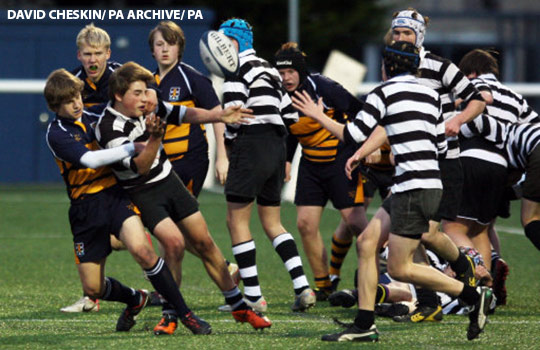Evidence shows that collision sports, such as youth rugby, carry high rates of injury
 Most injuries in youth rugby are due to the collision elements of the game, mainly the tackle. [1-8] In March 2016, scientists and doctors in the Sport Collision Injury Collective (SCIC) called for the tackle and other forms of harmful contact to be removed from school rugby. [9] The data in support of the call to remove the tackle and other forms of harmful contact in school rugby is compelling. We call on CMOs to act on the accumulating evidence and advise the UK government to put the interests of the child before the interests of corporate professional rugby unions and remove the tackle and other forms of harmful contact from the school game.
Most injuries in youth rugby are due to the collision elements of the game, mainly the tackle. [1-8] In March 2016, scientists and doctors in the Sport Collision Injury Collective (SCIC) called for the tackle and other forms of harmful contact to be removed from school rugby. [9] The data in support of the call to remove the tackle and other forms of harmful contact in school rugby is compelling. We call on CMOs to act on the accumulating evidence and advise the UK government to put the interests of the child before the interests of corporate professional rugby unions and remove the tackle and other forms of harmful contact from the school game.
Rugby union and rugby league are the most commonly played collision sports in the physical education curriculum of schools in England. [10] Collision sports where “athletes purposely hit or collide with each other or with inanimate objects (including the ground) with great force” include rugby, ice-hockey and American football. [11]
The few studies which compare youth injury rates between sports show higher rates of injury for collision sports than for non-collision contact sports. [12,13] A meta-analysis by Pfister et al found rugby, ice-hockey, and American football had the highest concussion rates in children, 4.18, 1.20, and 0.53 concussions per 1000 athlete exposures respectively. [13]
A survey carried out by the Australian Sports Medicine Federation across all age groups taking participation into account found rugby league, rugby union, and Australian rules football had the highest rates of injury. [14] A New Zealand study also across all age groups combining injury insurance claims data with exposure data from a range of surveys found playing rugby (one game every three weeks) was 460 to 530 times more dangerous than cycling (a half hour trip three times a week). [15]
Furthermore a New Zealand study using instrumented ear patches to measure head impact acceleration found that under nine year olds playing rugby union with tackling experienced head impacts of a similar magnitude to American high school and collegiate football players despite the rugby players being younger, lighter and slower [16]. Other studies show, rugby related injury emergency department attendances in the US are on the rise in particular head and face injuries which make up more than a third of injuries [17]; girls take three or four times longer to recover from concussion than boys [18]; a history of concussion is associated with a lowering of a person’s life chances across a range of social and educational measures including receipt of disability pension, psychiatric inpatient admissions or outpatient visits, premature mortality, low educational achievement and receipt of state welfare payments (p<0.05 for all) [19]; concussion is associated with an increase in violent behaviour and violent injury in adolescents the year following their concussion, with children exhibiting violent behaviour in year nine 2.34 (95% confidence interval 1.07 to 5.16, p<0.05) times more likely to have had a concussion in year eight than non-violent children and children who had received a violent injury in year nine, 2.96 (95% CI 1.33 to 6.58, p<0.01) times more likely to have had a concussion in year eight than non-injured children 20; and head injury is associated with an increased risk of any dementia, relative risk (RR) = 1.63 (95% CI 1.34 to 1.99) and Alzheimer’s disease, RR = 1.51 (95% CI 1.26 to 1.80) adding to existing evidence that head injury may lead to neurodegenerative diseases [21].
Rule changes in collision sports can make a difference. [22, 23] Canada imposed a ban on body-checking in Pee Wee (under 13 years) ice-hockey, where a player deliberately makes contact with an opposing player to separate them from the ice-puck; a subsequent systematic review and meta-analysis found an unadjusted 67% reduction, incidence rate ratio 0.33 (95% CI 0.25, 0.45), in concussion risk. The evidence for other strategies to reduce concussion risk in sport including the wearing of protective equipment such as mouthguards is weak. [23] The introduction of player education programmes in New Zealand and South African rugby was associated with a reduction in catastrophic injuries although not in other injuries including concussion. [24] In the UK, teacher training in the skills of rugby are lacking as is concussion awareness training. [25, 26]
In July 2016, the four UK chief medical officers (CMOs) rejected the call for a ban on tackling in youth rugby citing a report [27] they had commissioned from the Physical Activity Expert Group (PAEG) chaired by Professor Charlie Foster of University of Oxford and a paper [28] authored by two World Rugby employees, which claimed rugby was no more injury prone than other sports. The PAEG report [27] (unlike World Rugby’s paper) stated that rugby has a higher incidence of injury than other sports but did not consider the Rights of the Child.
It is well recognised that children are vulnerable and require specific measures to control the unique risks associated with this group. [29] The call for a cautionary approach and the removal of collision from school rugby and to end compulsion in the school game is likely to reduce and mitigate the risk of injury in school children. Under the United Nations Convention on the Rights of the Child (Article 19) governments have a duty to protect children from risks of injury and to ensure the safety of children, which is why we are calling on CMOs to act now. [30]
Allyson M Pollock is professor of public health and Director of Institute of Health and Society in the Medical Faculty of Newcastle University. She is a public health doctor and has been researching injuries and rugby injuries for more than ten years.
Graham Kirkwood is a former NHS nurse and works as a senior research associate in the Institute of Health and Society at Newcastle University with interests in injuries and access to healthcare.
Competing interests: None declared.
Not commissioned, peer reviewed.
References:
- Freitag A, Kirkwood G, Scharer S, Ofori-Asenso R, Pollock AM. Systematic review of rugby injuries in children and adolescents under 21 years. Br J Sports Med 2015;49(8):511-9. doi: 10.1136/bjsports-2014-093684
- Kirkwood G, Parekh N, Ofori-Asenso R, Pollock AM. Concussion in youth rugby union and rugby league: a systematic review. Br J Sports Med 2015;49(8):506-10. doi: 10.1136/bjsports-2014-093774
- Bleakley C, Tully M, O’Connor S. Epidemiology of adolescent rugby injuries: a systematic review. J Athl Train 2011;46(5):555-65.
- Burger N, Lambert MI, Viljoen W, Brown JC, Readhead C, Hendricks S. Tackle technique and tackle-related injuries in high-level South African Rugby Union under-18 players: real-match video analysis. Br J Sports Med 2016;50(15):932-8. doi: 10.1136/bjsports-2015-095295
- Hendricks S, O’Connor S, Lambert M, et al. Contact technique and concussions in the South African under-18 Coca-Cola Craven Week Rugby tournament. Eur J Sport Sci European journal of sport science 2015;15(6):557-64. doi: 10.1080/17461391.2015.1046192
- Archbold HA, Rankin AT, Webb M, et al. RISUS study: Rugby Injury Surveillance in Ulster Schools. Br J Sports Med British journal of sports medicine 2017;51(7):600-6. doi: 10.1136/bjsports-2015-095491
- Leung FT, Franettovich Smith MM, Brown M, Rahmann A, Mendis MD, Hides JA. Epidemiology of injuries in Australian school level rugby union. J Sci Med Sport Journal of science and medicine in sport / Sports Medicine Australia 2017;20(8):740-4. doi: 10.1016/j.jsams.2017.03.006
- Leung FT, Franettovich Smith MM, Hides JA. Injuries in Australian school-level rugby union. J Sports Sci 2017;35(21):2088-92. doi: 10.1080/02640414.2016.1255771
- Sport Collision Injury Collective. Open Letter: Preventing injuries in children playing school rugby. 01 Mar 2016. www.sportcic.com/resources/Open%20Letter%20SportCIC%20March1st%202016.pdf.
- Department for Education. GCSE PE activity list. Jan 2015. www.gov.uk/government/uploads/system/uploads/attachment_data/file/447738/GCSE_activity_list_for_PE.pdf.
- Rice SG. Medical conditions affecting sports participation. Pediatrics 2008;121(4):841-8. doi: 10.1542/peds.2008-0080
- Spinks AB, McClure RJ. Quantifying the risk of sports injury: a systematic review of activity-specific rates for children under 16 years of age. Br J Sports Med 2007;41(9):548-57. doi: 10.1136/bjsm.2006.033605
- Pfister T, Pfister K, Hagel B, Ghali WA, Ronksley PE. The incidence of concussion in youth sports: a systematic review and meta-analysis. Br J Sports Med 2016;50(5):292-7. doi: 10.1136/bjsports-2015-094978
- Routley V, Ozanne-Smith J. Hazard (Edition No. 8). Sport related injuries – an overview. Oct 1991. www.monash.edu/__data/assets/pdf_file/0006/218445/haz08.pdf.
- Chieng M, Lai H, Woodward A. How dangerous is cycling in New Zealand? J Transp Health 2017. doi: 10.1016/j.jth.2017.02.008i
- King DA, Hume PA, Gissane C, Clark TN. Similar head impact acceleration measured using instrumented ear patches in a junior rugby union team during matches in comparison with other sports. J Neurosurg Pediatr 2016;18(1):65-72. doi: 10.3171/2015.12.PEDS15605
- Sabesan V, Steffes Z, Lombardo DJ, Petersen-Fitts GR, Jildeh TR. Epidemiology and location of rugby injuries treated in US emergency departments from 2004 to 2013. Open Access J Sports Med 2016;7:135–42. doi: 10.2147/OAJSM.S114019
- Miller JH, Gill C, Kuhn EN, Rocque BG, et al. Predictors of delayed recovery following pediatric sports-related concussion: a case-control study. J Neurosurg Pediatr 2016;17(4):491-6. doi: 10.3171/2015.8.PEDS14332
- Sariaslan A, Sharp DJ, D’Onofrio BM, Larsson H, Fazel S. Long-Term Outcomes Associated with Traumatic Brain Injury in Childhood and Adolescence: A Nationwide Swedish Cohort Study of a Wide Range of Medical and Social Outcomes. PLoS Med 2016;13(8):e1002103. doi: 10.1371/journal.pmed.1002103
- Buckley L, Chapman RL. Associations between self-reported concussion with later violence injury among Australian early adolescents. J Public Health (Oxf) 2017;39(1):52-7. doi: 10.1093/pubmed/fdw009
- Li Y, Li Y, Li X, et al. Head Injury as a Risk Factor for Dementia and Alzheimer’s Disease: A Systematic Review and Meta-Analysis of 32 Observational Studies. PloS one 2017;12(1):e0169650. doi: 10.1371/journal.pone.0169650
- Vriend I, Gouttebarge V, Finch CF, van Mechelen W, Verhagen EA. Intervention Strategies Used in Sport Injury Prevention Studies: A Systematic Review Identifying Studies Applying the Haddon Matrix. Sports Med 2017. doi: 10.1007/s40279-017-0718-y
- Emery CA, Black AM, Kolstad A, et al. What strategies can be used to effectively reduce the risk of concussion in sport? A systematic review. Br J Sports Med 2017;51(12):978-984. doi: 10.1136/bjsports-2016-097452
- Freitag A, Kirkwood G, Pollock AM. Rugby injury surveillance and prevention programmes: are they effective? BMJ 2015;350:h1587. doi: 10.1136/bmj.h1587
- Oxfordshire Rugby Football Schools Union. Training Audit. Oct 2015.
- Shibli S, Moore R, Barrett D, Edmondson L, Christy L, Millar R. All Schools Monitoring Report – Autumn Term: Sheffield Hallam University. Sport Industry Research Centre. 16 Mar 2015.
- The four UK Chief Medical Officers. RE: Open Letter: Preventing injuries in children playing school rugby including UK Physical Activity Expert Group – Response to Sports Collision Injury Collective (SCIC) Letter for UK CMOs. 29 Jul 2016.
- Tucker R, Raftery M, Verhagen E. Injury risk and a tackle ban in youth Rugby Union: reviewing the evidence and searching for targeted, effective interventions. A critical review. Br J Sports Med 2016;50(15):921-5. doi: 10.1136/bjsports-2016-096322
- Fuller C, Drawer S. The application of risk management in sport. Sports Med 2004;34(6):349-56.
- UNICEF. United Nations Convention on the Rights of the Child, 02 Sep 1990. www.unicef.org.uk/crc.
